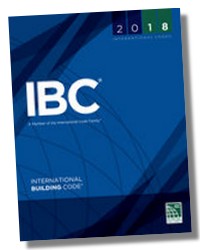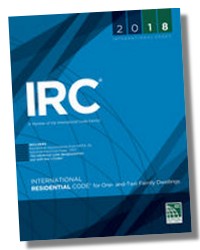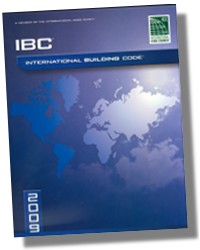|

2018
International Building Code -
Softcover
DE-1609837355
$146.95 |
|
|
2018
International Building Code -
Looseleaf
DE-1609837347
$167.95 |
|
|
Related: |

2018
International Residential Code

2009
International Building Code
|
2018
International Building Code
International Code Council (ICC)
The
International Building Code (IBC) covers all buildings except
detached one and two family dwellings and townhouses not more than 3
stories in height.
The 2018 IBC contains many important
changes such as:
- Accessory storage spaces of any size are now
permitted to be classified as part of the occupancy to which they
are accessory.
- New code sections have been introduced addressing
medical gas systems and higher education laboratories.
- Use of fire walls to create separate buildings
is now limited to only the determination of permissible types of
construction based on allowable building area and height.
- Where an
elevator hoistway door opens into a fire-resistance-rated corridor,
the opening must be protected in a manner to address smoke intrusion
into the hoistway.
- The occupant load factor for business uses has
been revised to one occupant per 150 square feet.
- Live loads on
decks and balconies increase the deck live load to one and one-half
times the live load of the area served.
- The minimum lateral load
that fire walls are required to resist is five pounds per square
foot.
- Wind speed maps updated, including maps for
the state of Hawaii.
- Terminology describing wind speeds has changed
again with ultimate design wind speeds now called basic design wind
speeds.
- Site soil coefficients now correspond to the newest
generation of ground motion attenuation equations (seismic values).
- Five-foot tall wood trusses requiring
permanent bracing must have a periodic special inspection to verify
that the required bracing has been installed.
- New alternative
fastener schedule for construction of mechanically laminated decking
is added giving equivalent power-driven fasteners for the 20-penny
nail.
- Solid sawn lumber header and girder spans for
the exterior bearing walls reduce span lengths to allow #2 Southern
Pine design values.
Table of Contents:
1. Scope and Administration.
2. Definitions.
3. Occupancy Classification and Use.
4. Special Detailed Requirements Based on Use and Occupancy.
5. General Building Heights and Areas.
6. Types of Construction.
7. Fire and Smoke Protection Features.
8. Interior Finishes.
9. Fire Protection Systems and Life Safety Systems.
10. Means of Egress.
11. Accessibility.
12. Interior Environment.
13. Energy Efficiency.
14. Exterior Walls.
15. Roof Assemblies and Rooftop Structures.
16. Structural Design.
17. Special Inspections and Tests.
18. Soils and Foundations.
19. Concrete.
20. Aluminum.
21. Masonry.
22. Steel.
23. Wood.
24. Glass and Glazing.
25. Gypsum Board, Gypsum Panel Products and Plaster.
26. Plastic.
27. Electrical.
28. Mechanical Systems.
29. Plumbing Systems.
30. Elevators and Conveying Systems.
31. Special Construction.
32. Encroachments into the Public Right-of-Way.
33. Safeguards During Construction.
34. Reserved.
35. Referenced Standards.
36. Appendix A: Employee Qualifications.
37. Appendix B: Board of Appeals.
38. Appendix C: Group U—A.
39. Appendix D: Fire Districts.
40. Appendix E: Supplementary Accessibility Requirements.
41. Appendix F: Rodent Proofing.
42. Appendix G: Flood-Resistant Construction.
43. Appendix H: Signs.
44. Appendix I: Patio Covers.
45. Appendix J: Grading.
46. Appendix K: Administrative Provisions.
47. Appendix L: Earthquake Recording Instrumentation.
48. Appendix N: Replicable Buildings.
Related:
 Building Code
Related
Building Code
Related
1609837355,
9781609837358
1609837347, 9781609837341
|
| |
|